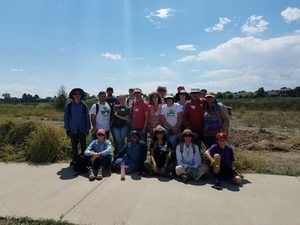By Amy Yarger, Butterfly Pavilion
 If you’re reading this blog, you’re probably familiar with the tenets of integrated pest management (IPM) in your plant collections and landscape. Due to some recent alarming die-offs of both native and managed bees, as well as widespread declines in pollinator populations, agriculture scientists are promoting the benefits of an IPPM approach. The extra “p” is for pollinators, those small (and I think adorable) animals that play the role of Cupid in plant reproduction. Because of the zoo world’s emphasis on conservation and our role as highly visible models for sustainable landscaping, this model may be a good fit for zoo horticulture as well.
If you’re reading this blog, you’re probably familiar with the tenets of integrated pest management (IPM) in your plant collections and landscape. Due to some recent alarming die-offs of both native and managed bees, as well as widespread declines in pollinator populations, agriculture scientists are promoting the benefits of an IPPM approach. The extra “p” is for pollinators, those small (and I think adorable) animals that play the role of Cupid in plant reproduction. Because of the zoo world’s emphasis on conservation and our role as highly visible models for sustainable landscaping, this model may be a good fit for zoo horticulture as well.
First of all, IPPM merely adds another lens through which to conduct regular pest management in the outdoor landscape; it does not require all new tools and processes. IPPM monitoring protocols track and document pests, but also investigate what pollinators are in the area and what plants they use for forage and shelter throughout the year. When pest management tactics are implemented, the tracking of pollinator populations before and after provides insights about potential harmful effects.
Thresholds may also shift under IPPM, especially in areas designated as “butterfly gardens”. After all, caterpillar is only another word for baby butterfly. If you can’t abide chewing on milkweed, a monarch habitat is probably not the garden for you! On the flip side, managing infestations while they are small and not established, may allow one to avoid extreme pest management measures. Plants that are “problem children” are disinvited from the garden party.
Many physical, cultural and biological methods are compatible with sustaining healthy pollinator populations. Not all, however – have you ever seen a praying mantis devour a butterfly? I have! It is important to note also that chemical pesticide use is not necessarily forbidden – a thorough examination of what, when and how a chemical is used is key. Also, the IPPM approach places emphasis on timing and prevention of contamination of the surrounding habitat. Chemicals that have not demonstrated negative effects on pollinators still must be used with every precaution to prevent collateral damage. Once you see a bee die-off, you never want to see one again!
In outdoor landscapes, IPPM focuses not only on plant health, but on biodiversity and ecosystem services, creating opportunities for pollinators as well as other beneficial insects and even vertebrates such as songbirds. Ecosystem gardens cultivate a livelier aesthetic that encourages exploration and discovery and allows connectivity for urban wildlife. If your zoo has expressed an interest in pollinator conservation or education, IPPM might be worth looking into!